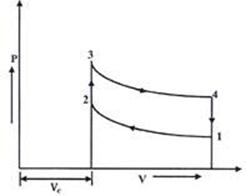Solved Previous Year GATE Questions on I.C Engines
Question 1. In a spark ignition engine working on the ideal Otto cycle, the compression ratio is 5.5.The work output per cycle (i.e., area of the P-V diagram) is equal to 23.625 , where
, where  is the clearance volume in
is the clearance volume in  . The indicated mean effective pressure is
. The indicated mean effective pressure is
(A) 4.295 bar
(B) 5.250 bar
(C) 86.870 bar
(D) 106.300 bar
GATE-ME-2001
Hint 1. (Ans A)




Question 2. An ideal air standard Otto cycle has a compression ratio of 8.5. If the ratio of the specific heats of ( ) is 1.4, then what is thermal efficiency (in percentage) of the Otto cycle?
) is 1.4, then what is thermal efficiency (in percentage) of the Otto cycle?
(A) 57.5
(B) 45.7
(C) 52.5
(D) 95
GATE-ME-2002
Hint 2. (Ans A)


Question 3. For an engine operating on air standard Otto cycle, the clearance volume is 10% of the swept volume. The specific heat ratio of air is 1.4. The air standard cycle efficiency is
(A) 38.3 %
(B) 39.8 %
(C) 60.2 %
(D) 61.7 %
GATE-ME-2003
Hint 3. (Ans D)




Now


Now standard circle efficiency,


Question 4. An automobile engine operates at a fuel air ratio of 0.05, volumetric efficiency of 90% and indicated thermal efficiency of 30 %. Given that the calorific value of the fuel is 45 MJ/kg and the density of the air at intake is  , the indicated mean effective pressure for the engine is
, the indicated mean effective pressure for the engine is
(A) 6.075 bar
(B) 6.75 bar
(C) 67.5 bar
(D) 243 bar
GATE-ME-2003
Hint 4. (Ans A)
Given

















Question 5. A diesel engine is usually more efficient than a spark ignition engine because
(A) Diesel being a heavier hydrocarbon, release more heat per kg than gasoline
(B) The air standard efficiency of diesel cycle is higher than the Otto cycle, at a fixed compression ratio
(C) The compression ratio of a diesel engine is higher than that of an S.I engine
(D) Self ignition temperature of diesel is higher than that of gasoline.
GATE-ME-2003
Hint 5. (Ans C)
Question 6. For spark ignition engine, the equivalence ratio ( ) of mixture entering the combustion chamber has values
) of mixture entering the combustion chamber has values
(A)  for idling and
for idling and  for peak power conditions
for peak power conditions
(B)  for both idling and peak power conditions
for both idling and peak power conditions
(C)  for idling and
for idling and  for peak power conditions
for peak power conditions
(D)  for both idling and peak power conditions
for both idling and peak power conditions
GATE-ME-2003
Hint 6. (Ans B)
Question 7. An engine working on air standard Otto cycle has a cylinder diameter of 10 cm and stroke length of 15 cm. The ratio of specific heats for air is 1.4. If the clearance volume is 196.3 cc and the heat supplied per kg of air per cycle is 1800 kJ/kg, then work output per cycle per kg of air is
(A) 879.1 kJ/
(B) 890.2 kJ
(C) 895.3 kJ
(D) 973.5 kJ
GATE-ME-2004
Hint 7. (Ans D)
Given
Stroke volume,


Compression ratio,





Question 8. During a Morse test on a four cylinder engine, the following measurements of brake power were taken at constant speed.
All cylinders firing 3037 kW
Number 1 cylinder not firing 2102 kW
Number 3 Cylinder not firing 2100 kW
Number 4 cylinder not firing 2098 kW
The mechanical efficiency of the engine is
(A) 91.53 %
(B) 85.07 %
(C) 81.07 %
(D) 61.22 %
GATE-ME-2004
Hint 8. (Ans C)





Total I.P of the cylinder


Question 9. At the time of starting, idling and low speed operation, the carburetor supplies a mixture which can be termed as
(A) Lean
(B) Slightly leaner than stoichiometric
(C) Stoichiometric
(D) Rich
GATE-ME-2004
Ans D
Answer keys
1. (A) 2. (A) 3. (D) 4. (A) 5. (C) 6. (B) 7. (D) 8. (C) 9. (D)